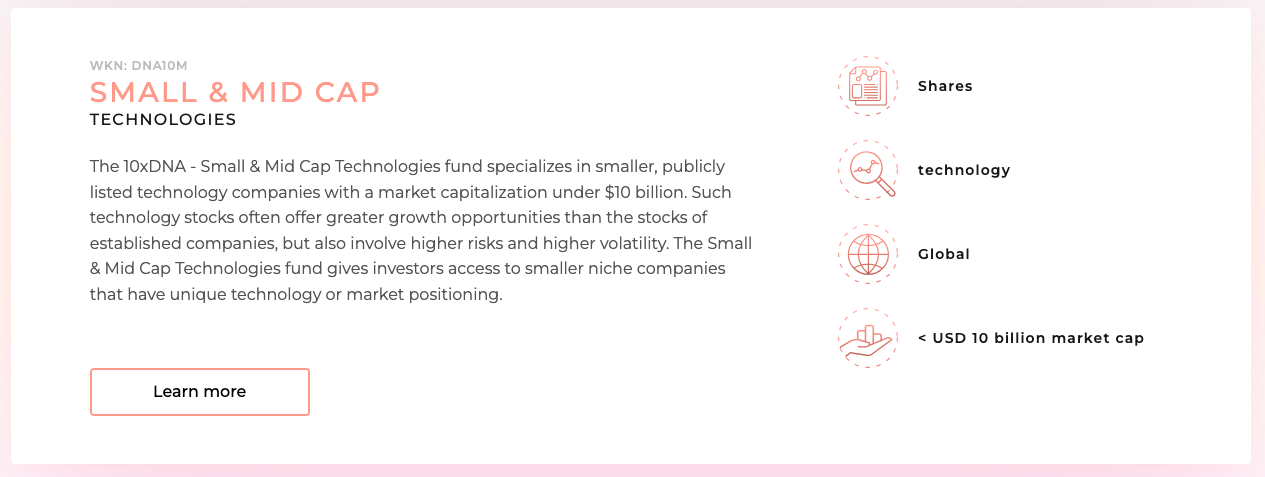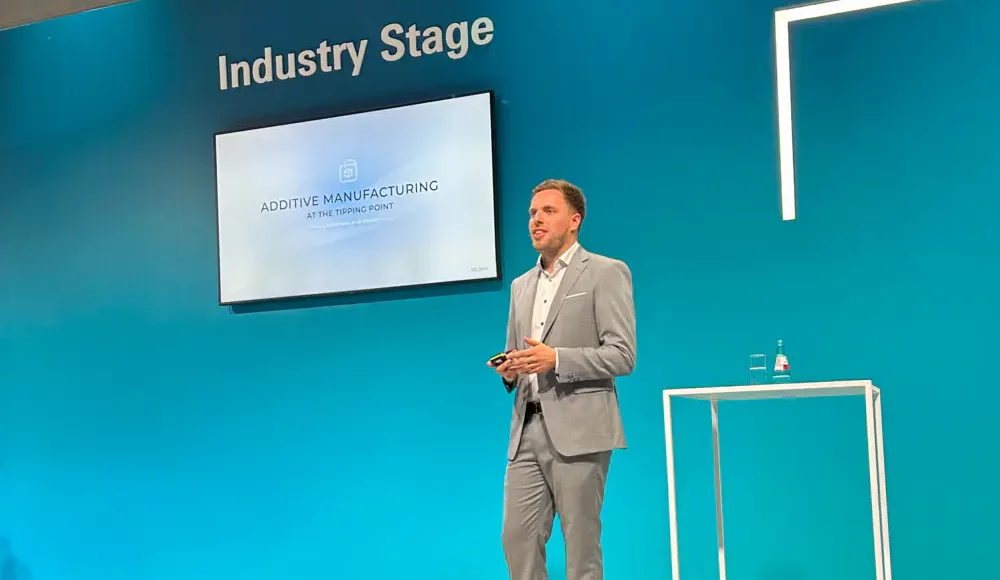In an age where the speed of technological advancements mean a constant reshaping of the business landscape, investment strategies too must evolve. 10xDNA Capital Partners (10xDNA), an investment fund based in Germany, exemplifies this shift. In an interview with 3DPrint.com, 10xDNA Senior Research Analyst Paul Schmidt provided an inside look at how the company navigates the complex world of investing in disruptive technologies, from AI and biotech to 3D printing and robotics.
From Dragon’s Den to Public Markets
Three years ago, 10xDNA was spun out of Freigeist Capital, a renowned venture capital (VC) firm established by Frank Thelen, one of the leading investors on Germany’s version of Shark Tank, Die Höhle der Löwen, or “Dragons Den.” While Freigeist focuses on seed funding for unique startups, 10xDNA is dedicated to public companies, retaining close ties to its VC origins.
There are an increasing number of tech-focused investment funds, including, notably, ARK Investment Management. Unlike ETFs that have a fixed investment structure, investment funds can dynamically adjust their investment portfolio in response to market changes. 10xDNA differentiates itself with a broad tech focus, clear expertise in technology sectors and a swift navigation due to its smaller fund size.

Through its Small & Midcap Fund, 10xDNA has invested in such publicly traded 3D printing companies as Markforged, Norsk Titanium, and Xometry.
At the core of 10xDNA’s strategy is a commitment to disruptive technologies. The firm is not just about investing in the current tech landscape, but is more focused on what the future holds. This forward-looking approach requires a broad and deep understanding of various sectors, especially the manufacturing sector, which Schmidt covers with a particular focus on 3D printing.
“We have a very holistic view of what’s going on in the technology world, talking to the management of most of the publicly traded 3D printing companies, as well as many end users. Thanks to our very good network in Germany, we regularly talk to manufacturers and users about their views on 3D printing.” Schmidt said, highlighting Daimler Trucks as a recent company with whom he spoke.
Kickstarting Growth During a Market Standstill
The current market for technology investments, particularly in 3D printing, has been challenging, with additive manufacturing (AM) firms struggling to maintain their stock prices. There was some hope that a potential merger between Stratasys and another company might lead to accelerated growth in the public markets, but once that merger fell through, stock prices have continued to drop. In some cases, companies like Desktop Metal have even fallen below the threshold for public listing on the New York Stock Exchange.
“This is a tough time for technology investors. What’s very interesting is that the so-called ‘Magnificent 7’—Microsoft, Apple, and the like—have outperformed the market strongly over the past few months. But if you look at small and mid-cap technology companies, the market has been almost flat,” Schmidt said. “We strongly believe this will change in the coming years as many of these companies actually deliver on their promises.”
Schmidt pointed out the additive manufacturing (AM) sector in particular, noting that some of the publicly traded stocks have been trading close to their cash positions.
“The whole 3D printing market is under a lot of pressure right now. Investment banks really don’t believe in the rapid adoption of 3D printing. One of the reasons is that they completely overpromised, claiming that they would sell tens of thousands of machines in a few years, and then ending up selling only a few. That backfired pretty badly, because now there’s very little trust from the investment community, and it’s going to be hard for some of the players to rebuild that trust. The whole 3D printing market is suffering as a result,” Schmidt said. “On the other hand, the change in interest policy and interest rates affects the whole market environment, which makes it even more difficult for disruptive technologies.”
Macrotrends Driving AM
However, 10xDNA sees potential in these challenges. The firm believes that the market dynamics, including factors such as reshoring and the shift from hardware-focused to software-centric approaches in 3D printing, will significantly influence market growth.
While artificial intelligence (AI) has been on the lips of the media and investors, Schmidt pointed out that reshoring is even more top of mind for most large businesses. According to the 10xDNA researcher, if you compare the earning transcripts of S&P 500 companies from this year to last year, reshoring was mentioned 128 percent more often in 2023 than 2022, which was even more of an increase than was seen with AI. Exemplifying the impact that AM could make in the world of distributed manufacturing, Schmidt referred to a study conducted by the AM manager at Daimler Trucks that determined that 20 percent of all spare parts across all industries get disposed of due to the cost of taking up warehouse space.
“A more resilient supply chain benefits greatly from 3D printing because it makes so much more sense to basically move your facility closer to the point of use and use 3D printers as it’s a fairly automated process. You can essentially print parts that you’d normally get from five different suppliers at once,” Schmidt said. “General market growth will also have a positive impact on the public AM sector. A lot of the traditional 3D printing companies focused primarily on hardware, but 3D printing is also a software game, and that mindset has changed. New players have focused heavily on software, or even spend more money on R&D and software than on hardware, which can make the whole business even more attractive.”
The edge that Chinese firms might have over European entities could be attributed to the intense competitiveness within China’s start-up sector and the close availability of a broad technological infrastructure, including the local manufacture of essential sub-parts. Although currently not investible due to regulatory constraints, Chinese AM companies are on 10xDNA’s radar because of their strong technological capabilities and rapid implementation speeds. The firm acknowledges the potential of these companies, while also being cognizant of the risks involved in the Chinese market.
Discussing the challenges and opportunities in the 3D printing sector, Schmidt acknowledges the mixed perceptions about Chinese companies: “A lot of legacy players in Europe fear their disruptive potential. They definitely have the tech talent, and they are very, very quick in implementation speed. What we hear from industry customers is that if they go with a company like Farsoon or BLT, they can get their solutions in four weeks, which they have tried with European legacy players for years. Meanwhile, others believe that machines from China never work and that there’s no quality. However, we know that Chinese products aren’t cheap copycats anymore. We’ve seen that in electric vehicles and so on.”
Profitability and Market Realities
Looking ahead, 10xDNA remains optimistic yet cautious. There is a growing emphasis on profitability among public AM companies. Investors are increasingly interested in seeing positive cash flows earlier, prompting many companies to reevaluate their strategies and focus more on profitability.
“If you look at the earnings of almost all the public 3D printing companies, most of them have reduced their headcount by 10 to 15 percent. And the reason for that is that investors want to see more or earlier positive cash flow for these companies. That is definitely something that has changed in the last year,” Schmidt said.
Because the 3D printing market has seen significant sell-offs in recent years, Schmidt believes there is limited room for further downturns. The recovery might be on the horizon, although predicting its exact timing is challenging.
Schmidt concluded, “From a valuation perspective, there isn’t much room for a further downturn. There’s been a very big sell-off in the last couple of years, and if you look at historical market pressures and crises, they don’t usually last 10 years. I think there will be a recovery, but I can’t look into a crystal ball and tell you the exact date. Obviously, this is not investment advice.”
Subscribe to Our Email Newsletter
Stay up-to-date on all the latest news from the 3D printing industry and receive information and offers from third party vendors.
You May Also Like
3D Printing News Briefs, April 27, 2024: Research, Digital Dentistry, Cycling, & More
We’re starting today’s 3D Printing News Briefs with some research into 3D printed luminescent quantum-dot polymer architectures and free-form laser beam shaping, and then on to an open source 4-axis...
HP & INDO-MIM Collaborate to Boost Metal 3D Printing in India
HP Inc. and INDO-MIM, a US- and India-based supplier of metal injection molding (MIM) powders and contract manufacturer, have announced that the two companies will collaborate to accelerate additive manufacturing...
3D Printing News Briefs, February 17, 2024: Shot Blasting, Service Bureaus, & More
In today’s 3D Printing News Briefs, we’re starting out with post-processing, as SKZ Würzburg is using a shot blast system from AM Solutions for its research. Moving on to business,...
3D Printing News Unpeeled: Not That Kind of Organ 3D Printing
GKN Aerospace will create a 150 jobs in Trollhattan Sweden with an investment of $60 million part of which comes from the Swedish Energy Agency’s Industriklivet initiative. The investment will...































